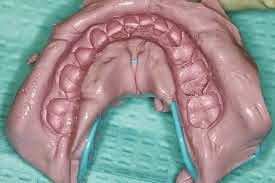Alginate is an elastic impression material made from seaweed. It is also comprised of sodium alginate, calcium sulfate and retarders. It is used to take primary or preliminary impressions. This colloidal material forms a gel when the powder is mixed with water. It solidifies into an elastic mass capable of producing a negative reproduction of the oral cavity (an impression). It is sometimes referred to as an irreversible hydrocolloid because once it is mixed a chemical reaction has occurred. Therefore, it can never return to its original state of powder and water. Alginate impressions are taken to obtain diagnosticstudy models, which are the positive reproductions of the teeth and surrounding structures. They are also used to fabricate bleaching trays and mouthguards. Alginate is the most universally utilized impression material in dentistry.
The following are characteristics of an ideal alginate impression material:
- cost effective
- easy to mix
- adequate flow properties
- non-toxic or irritating
- sufficient strength to avoid tearing material upon removal from the mouth
- acceptable working and setting times
- compatible with gypsum products
- patient acceptability
- adequate shelf life
Flavoring the impression material makes the procedure more palatable for the patient. Bubble gum, grape and mint are examples of flavors that may be already incorporated into the powder. For unflavored alginates, flavored liquid drops can be added to the water before mixing the alginate. Offering the patient a choice of flavors often gives the individual a feeling of control. This can enhance the patient’s cooperation level, thus producing a pleasant experience.
Antimicrobial agents are incorporated into some brands of alginate but do not substitute for disinfection. Rinse the impression under gently running, room temperature tap water. Spray the impression and tray with an immediate-level hospital grade (capable of killing tuberculocidal activity) disinfectant of choice (The most accurate casts are associated with disinfection of alginate impressions by spray rather than by immersion.). Place the sprayed impression in a plastic bag, seal the bag tightly, and allow the impression to remain for the amount of contact time recommended by the manufacturer. A label can be affixed to the bag for proper identification. After the required amount of time, remove the impression from the bag and, under room temperature tap water, gently rinse the disinfectant away. Pour as usual.
IMPORTANT: If disinfection of the impression is not completed properly, the gypsum cast will be contaminated and capable of transmitting disease.
Alginate may be manufactured with chromatic agents that have color indicators in the powder. The color of the mix changes throughout the manipulation of the product. For example, the white powder may change to a deep purple during the mixing phase, turn pink for insertion into the tray and then turn white when the tray is seated. These color changes alert the operator when to end spatulation, when to fill the tray and when the alginate has set. This built-in indicator is an excellent guide for the operator to gauge the various stages of the procedure.
The tray does not have to be seated until the last color change, thus reducing the amount of time the tray remains in the patient’s mouth. This feature is particularly important for the patient with gagging tendencies. These color changes vary with each manufacturer and may vary based upon the ph of the water used.


0 comments:
Post a Comment